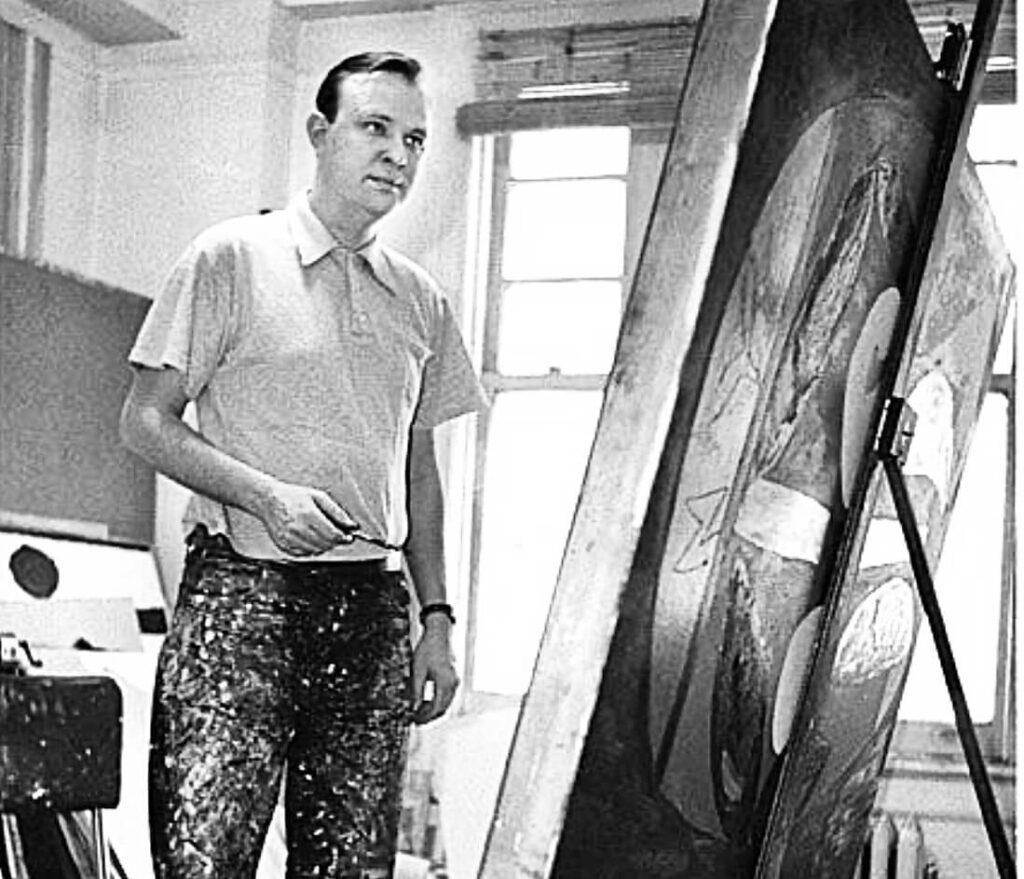Robert Motherwell
Robert Motherwell was a significant figure in the Abstract Expressionist movement, known for his intellectual approach to painting and his ability to blend European modernism with American abstract art. His works are celebrated for their emotional depth, philosophical undertones, and innovative techniques, making him a pivotal artist of the 20th century.

Early Life and Education
Born on January 24, 1915, in Aberdeen, Washington, Motherwell grew up in a cultured and educated family. His father was a banker, and his mother was an artistically inclined homemaker. Motherwell’s family moved frequently, and he spent his formative years in California, developing an early appreciation for art and literature.
Motherwell pursued a well-rounded education, earning a bachelor’s degree in philosophy from Stanford University in 1937. He continued his studies at Harvard University, where he engaged deeply with philosophy and art history. His exposure to modernist European art during his travels in Europe significantly influenced his artistic development.
Introduction to Abstract Expressionism
Motherwell’s artistic career began in earnest in the early 1940s, after moving to New York City. There, he became part of a circle of avant-garde artists, including Jackson Pollock, Willem de Kooning, and Mark Rothko. His intellectual background and philosophical interests set him apart, allowing him to approach Abstract Expressionism with a unique perspective.
In New York, Motherwell studied under the German surrealist Kurt Seligmann and formed friendships with influential artists and critics like Peggy Guggenheim and Clement Greenberg. His early works were influenced by surrealist automatism, a technique that involved creating art without conscious control, allowing the subconscious mind to guide the process.
Artistic Development and Notable Works
Motherwell’s artistic style evolved throughout his career, but he consistently maintained a focus on emotional expression, intellectual rigor, and formal experimentation. His works often explored themes of conflict, mortality, and the human condition.
1. “Elegy to the Spanish Republic No. 110” (1971)
One of Motherwell’s most famous series, “Elegy to the Spanish Republic,” consists of over 150 paintings created between 1948 and 1991. These works were inspired by the Spanish Civil War and serve as a meditation on the tragedy and loss associated with political conflict. “Elegy to the Spanish Republic No. 110” is a prime example of this series, characterized by its bold, black shapes and somber tones.
The composition features large, ovoid shapes interspersed with vertical bars, creating a rhythmic, almost musical quality. The use of black and white evokes a sense of mourning and solemnity, reflecting Motherwell’s deep empathy for the suffering caused by war. This series remains a powerful testament to Motherwell’s ability to convey profound emotion through abstraction.

2. “Open Series: In Blue with Charcoal Line” (Late 1960s)
The “Open” series, which Motherwell began in the late 1960s, represents another significant phase in his career. These works are characterized by their simplicity and minimalism, featuring large, open rectangles set against monochromatic backgrounds. “Open No. 24: In Blue with Charcoal Line” exemplifies this series with its serene composition and subtle use of color.
The painting features a large, rectangular shape in a soft blue hue, outlined with a charcoal line. The simplicity of the composition belies its complexity, as the interplay of color, line, and space creates a sense of depth and contemplation. The “Open” series reflects Motherwell’s interest in Zen Buddhism and his desire to create meditative, introspective works.

3. “Spanish Picture with Window” (1941)
“Spanish Picture with Window” is an early work that showcases Motherwell’s engagement with surrealism and automatism. Created during his time in Mexico, the painting features abstract, organic shapes and a dreamlike quality. The composition is divided into two parts, with a window-like form on one side and a series of biomorphic shapes on the other.
The use of vibrant colors and fluid forms reflects Motherwell’s interest in the subconscious mind and the surrealist movement. This work marks an important moment in his career, as he began to develop his distinctive style and explore the possibilities of abstraction.

Techniques and Innovations
Motherwell’s approach to painting was characterized by his intellectual rigor and willingness to experiment with different techniques and styles. He often employed automatism, allowing his subconscious mind to guide his brush, and incorporated elements of collage into his works. His use of bold, gestural brushstrokes and stark contrasts created a sense of immediacy and emotional intensity.
Motherwell was also deeply influenced by literature and philosophy, which informed his approach to art. He believed that painting should be an expression of the artist’s inner life and emotions, and he often used his works to explore complex themes such as existentialism, mortality, and political conflict.
Personal Life and Influence
Motherwell’s personal life was marked by both triumphs and challenges. He was married four times, with his relationships often influencing his work. His second marriage to the artist Helen Frankenthaler was particularly significant, as the couple shared a deep intellectual and artistic bond. Despite their eventual divorce, their relationship had a lasting impact on Motherwell’s work and career.
Motherwell’s influence extended beyond his own paintings. He was a dedicated teacher and mentor, teaching at institutions such as Hunter College and the University of California, Berkeley. He also edited several important publications on modern art, including “Possibilities” and “Documents of Modern Art,” helping to shape the discourse around Abstract Expressionism and modern art.
Legacy and Recognition
Robert Motherwell’s contributions to Abstract Expressionism and modern art are widely recognized and celebrated. His works are housed in major museums and collections around the world, including the Museum of Modern Art in New York, the Guggenheim Museum, and the Tate Modern in London. His influence can be seen in the work of subsequent generations of artists who continue to explore the possibilities of abstraction and emotional expression.
Motherwell’s legacy is also reflected in the continued relevance of his works, which continue to resonate with contemporary audiences. His ability to blend intellectual rigor with emotional depth and his willingness to experiment with different techniques and styles have cemented his place as one of the most important artists of the 20th century.
Conclusion
Robert Motherwell was a pioneering figure in Abstract Expressionism, whose intellectual approach to painting and innovative techniques left a lasting impact on modern art. Through his most notable works, such as “Elegy to the Spanish Republic No. 110,” “Open No. 24: In Blue with Charcoal Line,” and “Spanish Picture with Window,” Motherwell explored complex themes and conveyed profound emotions, creating powerful and evocative compositions that continue to inspire and challenge viewers. His legacy as a philosopher-painter and a key figure in the Abstract Expressionist movement endures, leaving an indelible mark on the art world.



